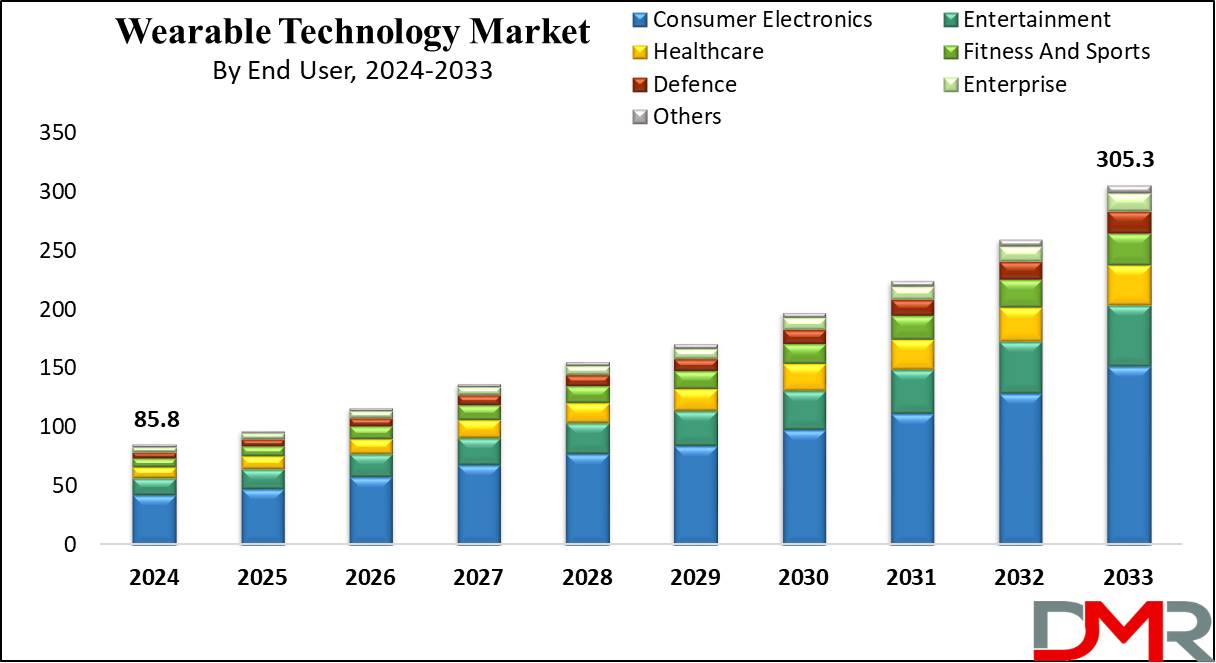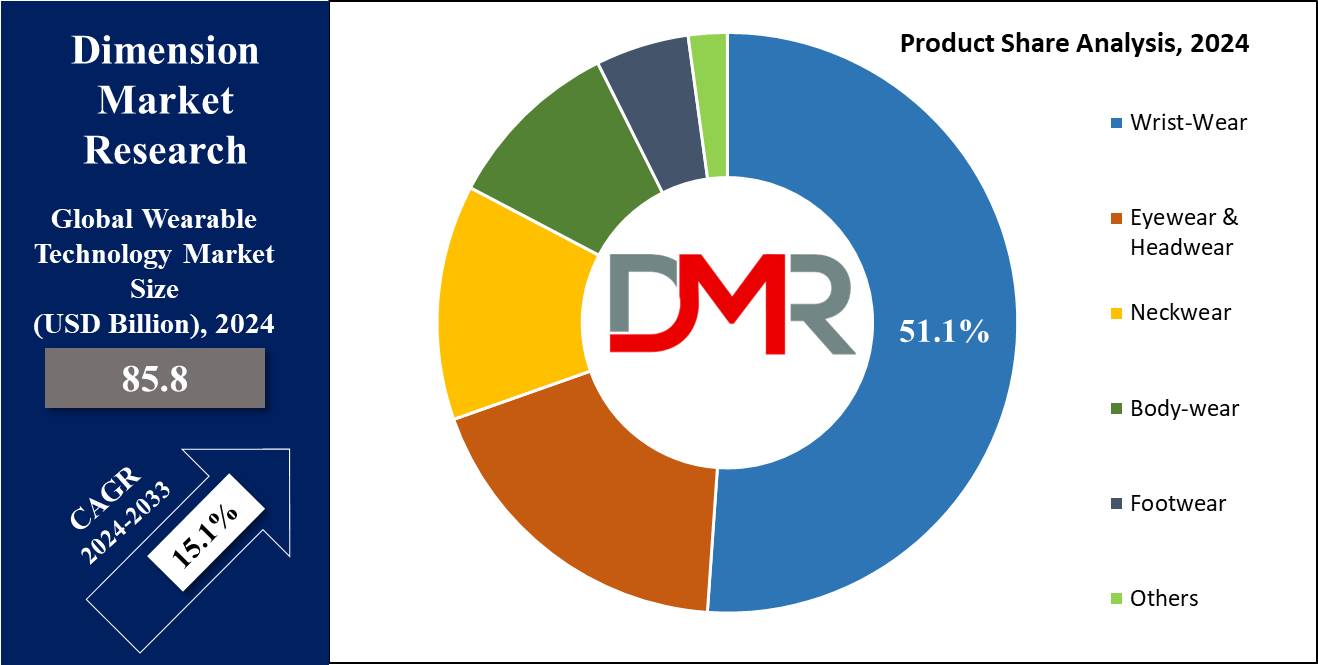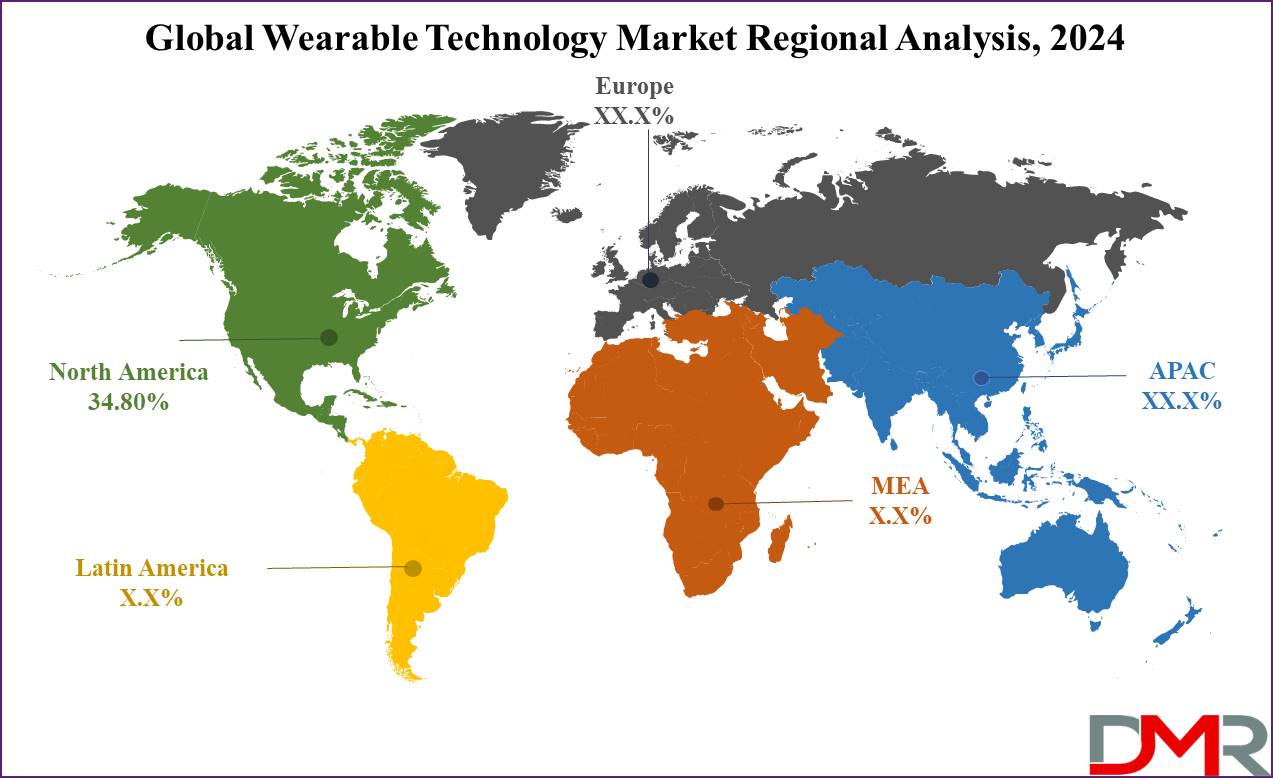The growth of this market is driven by the global adoption of wearable technology, with consumers utilizing gadgets that effortlessly become an integrated part of their daily activities. Human-wearable technologies cover a great variety of products starting from smartwatches and exercise trackers to augmented reality glasses and clothes. The main factors shaping its growth are increasing interest in fitness, a need for connection and comfort, and sensor development.

Major companies in this market will continue developing innovative ways to add more useful features such as those that monitor health, GPS monitoring, and contactless payments, fitting the dynamic needs of consumers. Besides, with the introduction of artificial intelligence and
machine learning, such wearable devices are also able to offer more advanced features and higher user satisfaction. The advent of the Internet of Things (IoT) ties up the vision of the wearable technology that interconnects people to the surrounding environment and it becomes the primary bridge for humans and technologies to interact with each other.
As per Techreport, the Wearable Technology Market is poised for significant shifts in 2024, with analysts projecting a 2% revenue decline, bringing market volume to $17.85 billion. Penetration rates are also forecasted to drop to 4.8%. Despite this, smartwatches remain the dominant product, with 20.1 million units sold in the U.S. and 148.74 million globally in 2019, rising to 22 million in the U.S. and 186.89 million worldwide by 2020. Apple leads this segment with a 47.9% market share, followed by Samsung at 13.4%.
Globally, 34% of wearable tech users are low-income earners, 41% are medium-income, and 25% are high-income. Men account for 63% of smartwatch users, while 37% are women. The primary age group is 25–34, comprising 36.4% of users, followed by 35–44 at 26.3%. Notably, 41% of Americans use wearables for health monitoring, including
wearable medical devices that track critical health indicators. IoT adoption drives further growth, with 29% of North American and European organizations already leveraging wearable tech.
In the wearable technology sector, several notable developments have occurred recently. EssilorLuxottica, the world's largest eyewear manufacturer, achieved a valuation of €100 billion, driven by innovative smart eyewear developed in partnership with Meta. These smart glasses, particularly the Ray-Ban Meta, have contributed to quarterly sales growth and are expected to eventually replace smartphones.
Additionally, Bizzabo, an event management platform, acquired Klik, a Montreal-based event tech startup specializing in smart wearables, for $13.5 million. This acquisition aims to enhance in-person events by integrating wearable technology to create immersive, data-driven experiences.
These developments underscore the growing integration of wearable technology across various industries, from fashion to event management, highlighting the sector's dynamic nature and its expanding role in enhancing user experiences.
Key Takeaways
- Market Value: The market size is projected to reach a market value of USD 97.4 billion in 2025, in comparison to USD 305.3 billion in 2033 at a CAGR of 15.1%.
- Market Definition: Wearable technology refers to electronic devices worn on the body, able to amass facts, present records, and facilitate verbal exchange, generally through sensors and wireless connectivity. This includes wearable medical devices, wearable fitness technology, and wearable activity trackers.
- Product Segment Analysis: Wristwear is expected to exert its dominance in the product segment with a market value of 51.1% by the end of 2024.
- Technology Segment Analysis: IoT-based wearable products are projected to exert their prominence in the technology segment with the highest market share in 2024.
- Application Segment Analysis: Consumer electronics is projected to command the wearable technology market with a 49.5% market value in 2024.
- End User Segment Analysis: The healthcare and fitness sector is expected to dominate this market with the highest market share in 2024.
- Regional Analysis: North America is predicted to dominate the wearable technology market with 33.80% of the market share in 2024.
Use Cases
- Fitness Tracking: Wearable gadgets such as wearable fitness technology and wearable activity trackers oversee physical activity, heart rate, and sleeping patterns, helping users attain fitness goals.
- Health Monitoring: Wearables track crucial signs and symptoms like blood pressure and glucose levels, permitting individuals to control emergencies more efficiently.
- Navigation Assistance: Smart glasses and helmets provide real-time instructions, improving navigation for cyclists, hikers, and workers in complicated environments.
- Virtual Reality (VR): VR headsets provide immersive experiences for gaming, education, and training, transporting users to simulated environments.
- Contactless Payments: Smartwatches and wristbands equipped with payment technology allow secure transactions without the need for physical cards or cash.
Market Dynamic
The wearable technology market growth is pushed by various factors. Key drivers encompass growing health awareness amongst customers, mainly due to an extra demand for fitness trackers, smartwatches, and fitness tracking gadgets. Additionally, the convergence of favor and technology has fueled the adoption of wearables as elegant accessories, appealing to a broader customer base.
The ongoing technological advancements, especially in sensor technology, battery life, and connectivity, continue to fuel the functionality and value of wearable devices, driving innovation and product differentiation amongst manufacturers. Moreover, the proliferation of smartphones and the Internet of Things (IoT) in this market has created synergies that permit seamless integration and interoperability between wearables and other connected devices, expanding their utility and convenience.
Market dynamics are also influenced by regulatory frameworks, privacy concerns, and data security issues. Striking stability between innovation and user privacy remains a primary aim for the major market players, prompting ongoing efforts to expand strong data protection mechanisms and comply with evolving regulations.
Furthermore, collaborations among wearable technology businesses and healthcare companies, insurers, and corporate well-being packages are more and more common, fostering new business models and revenue streams. Overall, the wearable technology market is characterized by speedy innovation, evolving consumer preferences, and a landscape ready for steady growth and diversification. The wearable technology market is segmented based on product, technology, and end user.
Research Scope and Analysis
By Product
Based on product wristwear products are projected to dominate this segment in the global wearable technology market with 51.1% of the market share in 2024.

Wrist-wear dominates the wearable product segment primarily because of its versatility, convenience, and massive adoption in daily life. Smartwatches and health trackers, the 2 major categories of wrist-wear, offer several functionalities that cater to numerous consumer needs. These devices seamlessly combine into normal lifestyles, serving as now not simply tech gadgets but also fashion add-ons.
Smartwatches, in particular, have received substantial popularity for their capacity to perform a multitude of duties beyond simply telling time. They offer features including notifications, fitness monitoring, track playback, or even contactless bills, efficaciously replacing conventional watches for many users. Furthermore, smartwatches regularly serve as an extension of smartphones, permitting users to stay connected and productive on the move.
Fitness trackers, another form of wristwear, appeal to fitness-aware individuals searching to monitor their physical hobbies, sleep patterns, and standard well-being. Their lightweight and unobtrusive layout makes them comfortable to put on for the day, encouraging consistent usage.
By Technology
IoT-primarily based wearable generation will dominate the technology segment in 2024 because of its large applicability, seamless connectivity, and potential to combine with present ecosystems. IoT-enabled wearables leverage interconnected sensors and conversation technologies to collect and alternate data with different devices and structures, imparting users a comprehensive and interconnected experience. One key component pushing the dominance of IoT-based wearables is their versatility. These gadgets can serve multiple purposes beyond simple functionalities like fitness tracking or notifications.
They can screen numerous aspects of customers' lives, including health metrics, environmental conditions, or even domestic automation. This versatility appeals to an extensive variety of customers, from health enthusiasts to individuals looking to optimize their day-by-day exercises.
Additionally, IoT-based wearables excel in connectivity. They give users the ability to speak with smartphones, smart home devices, and different IoT-enabled devices seamlessly, allowing customers to get access and control multiple aspects of their digital lives from a single tool.
This interconnectedness enhances user convenience and productivity, pushing the demand for IoT-based wearables. Overall, the IoT-based wearable generation dominates the phase due to its versatility, connectivity, and capability to seamlessly integrate into customers' lives and existing ecosystems, using tremendous adoption and innovation inside the wearable technology market.
By Application
Consumer electronics are anticipated to dominate the application segment in the global wearable technology market with 49.5% of the market share in 2024.
Consumer electronics dominate the wearable technology market’s application segment due to their higher appeal and regular relevance to consumers' lives. Wearable devices within the consumer electronics category, including smartwatches, health trackers, and augmented reality glasses, offer functionalities that resonate with a wide target audience, from tech enthusiasts to normal customers.
These devices seamlessly integrate into customers' daily routines, serving as extensions in their smartphones, enhancing productiveness, connectivity, and entertainment experiences.
Moreover, consumer electronics wearable devices regularly boast sleek designs, intuitive interfaces, and diverse features that cater to diverse needs and options. Whether it is tracking fitness goals, staying linked with notifications, or gaining access to enjoyment, these wearables offer a compelling blend of capability and comfort.
By End User
In the context of end users, healthcare and fitness are anticipated to dominate this segment in 2024. The healthcare and fitness sector dominates the wearable generation segment because of their intrinsic connection to personal well-being and the growing trend of individuals actively monitoring and dealing with their fitness. Wearable devices tailored for healthcare and health fitness offer users a means to track crucial health records, screen physical activity levels, and receive personalized insights into their normal wellness.
These gadgets empower customers to take proactive measures toward keeping a healthy lifestyle and handling persistent conditions effectively. Moreover, the increasing emphasis on preventive healthcare and the growing occurrence of lifestyle-related illnesses drive the need for wearable devices in this segment. Consumers are increasingly turning to wearable technology to aid their fitness goals, track progress, and make knowledgeable choices about their health conditions.
Additionally, advancements in sensor generation and statistics analytics allow healthcare specialists to remotely display patients' health conditions and provide well-timed interventions, improving patient health and lowering healthcare costs.
The Wearable Technology Market Report is segmented on the basis of the following:
By Product
- Wrist-Wear
- Eyewear & Headwear
- Neckwear
- Body-Wear
- Footwear
- Others
By Technology
- IoT Based
- AR and VR
- Others
By Application
- Consumer Electronics
- Entertainment
- Healthcare
- Fitness And Sports
- Defense
- Enterprise
- Others
By End User
- Healthcare and Fitness
- BFSI
- Gaming and Entertainment
- Fashion
- Travel
- Education
- Logistics & Warehouse
Regional Analysis
North America is projected to dominate the global wearable technology market with a
33.80% market share in 2024 due to various factors. North America dominates the wearable generation market it is home to several tech giants and innovative startups focusing on wearable technology development. Companies like Apple, Fitbit, and Garmin, among others, have a widespread presence in North America which drives the growth of this market. North America has a big and tech-savvy consumer base with excessive disposable income levels.

The populace's propensity to adopt new technology and embrace new trends contributes to the adoption of wearable devices. Furthermore, the region benefits from a strong infrastructure assisting technological advancements, along with research and development facilities, manufacturing abilities, and access to heavy capital investment. This conducive environment fosters innovation and fastens product development inside the wearable technology sector.
Moreover, North America's sturdy regulatory framework guarantees consumer protection and statistics privateness, instilling self-assurance within the market. Compliance with stringent guidelines such as FDA approvals for clinical devices in addition solidifies the region's position as a leader in wearable technology development and adoption. Additionally, North America's various industries, which include healthcare, health, entertainment, and consumer electronics, drive demand for wearable gadgets across various sectors, contributing to the vicinity's dominance in the worldwide marketplace.
By Region
North America
Europe
- Germany
- The U.K.
- France
- Italy
- Russia
- Spain
- Benelux
- Nordic
- Rest of Europe
Asia-Pacific
- China
- Japan
- South Korea
- India
- ANZ
- ASEAN
- Rest of Asia-Pacific
Latin America
- Brazil
- Mexico
- Argentina
- Colombia
- Rest of Latin America
Middle East & Africa
- Saudi Arabia
- UAE
- South Africa
- Israel
- Egypt
- Rest of MEA
Competitive Landscape
The global wearable technology market is highly competitive as key players continuously fight for market share and market leadership. Top wearable technology companies, such as Apple, Samsung, and Fitbit, continue to be the leading players in the market mainly due to the timely improvements in their products, brands, and large number of distribution networks.
Similarly, the gap between established brands such as Samsung and iPhone have been narrowed down by potential Xiaomi, Huawei, and Garmin incumbents providing quality services at cheaper rates and into exact market segments. Another thing that is worth mentioning is the expansion of the technology of big players like Google and Amazon to access the wearable tech that will give these companies the ability to leverage the advantage of their significant resources and incorporation systems.
Collaboration and partnerships including wearable technology firms and health care suppliers, fashion brands, and software developers are no common strategies to broadly expand market potential. In addition, the ongoing technological revolution in this marketplace caused wearable devices to include
artificial intelligence, augmented reality, and biometric sensors further fueling the competition towards more advanced and multi-functional solutions.
Some of the prominent players in the Global Wearable Technology Market are
- Xiaomi Global Community
- Huawei Technologies Co. Ltd.
- Nike Inc.
- Motorola Solutions Inc.
- Sony Corporation
- Google LLC
- HTC Corporation
- SAMSUNG
- Apple Inc.
- CASIO AMERICA INC.
- Fitbit Inc.
- Michael Kors
- ADIDAS AG
- Other Key Players
Recent Development
- In March 2024, Bengaluru-based Ultrahuman raised USD 35.0 million in Series B funding, led by Blume Ventures, to enhance health tracking with its smart ring and other innovative wearable devices, bringing total funding to over USD 60.0 million.
- In January 2024, Angelini Ventures invested USD 8.69 million in two American startups: Noctrix Health, Inc., which focuses on wearable medical devices for restless leg syndrome, and COUR Pharmaceuticals, utilizing nanotechnologies for autoimmune diseases like diabetes and celiac disease.
- In January 2024, Epicore Biosystems secured investment from Pegasus Tech Ventures and Denka Company Limited to scale its sweat-sensing wearables, which specialize in distribution in Japan and broader Asian markets.
- In December 2023, A South Asian brand Noise acquired a strategic investment from the renowned audio and electronic device manufacturer Bose.
- In October 2023, French start-up RDS secured USD 14.12 million in Seed capital from Capital Grand Est for its MultiSense Remote Patient Monitoring solution, offering a wearable patch and cloud-based platform for non-stop health tracking.
- In April 2022, Modjoul got investment from the Amazon Industrial Innovation Fund to increase its wearable-based system for workplace safety, enhancing worker mechanics, and integrating with a robotic system for predictive insights.